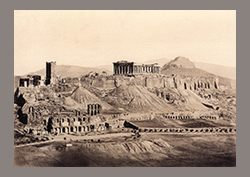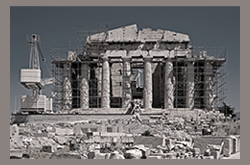scarica l’articolo in formato pdf: Criteri di reintegrazione strutturale nel restauro dei monumenti dell’Acropoli di Atene. Problemi metodologici e scelte progettuali
.
 Con la relazione “Criteri di reintegrazione strutturale nel restauro dei monumenti dell’Acropoli di Atene. Problemi metodologici-Scelte progettuali” vengono dispiegati i criteri in base ai quali si decide di procedere alla reintegrazione delle membrature architettoniche che vengono utilizzate nell’attuale restauro dei monumenti dell’Acropoli di Atene. Dopo un breve excursus storico dei restauri precedenti e una breve presentazione dei principi dei restauri odierni, prendendo in esame il restauro dei Propilei, la presente relazione ha cercato di sintetizzare questi criteri in cinque grandi categorie. Queste vengono illustrate attraverso esempi caratteristici di interventi ai Propilei degli ultimi dieci anni, nei quali emergono chiaramente sia i problemi metodologici che le scelte progettuali.
Con la relazione “Criteri di reintegrazione strutturale nel restauro dei monumenti dell’Acropoli di Atene. Problemi metodologici-Scelte progettuali” vengono dispiegati i criteri in base ai quali si decide di procedere alla reintegrazione delle membrature architettoniche che vengono utilizzate nell’attuale restauro dei monumenti dell’Acropoli di Atene. Dopo un breve excursus storico dei restauri precedenti e una breve presentazione dei principi dei restauri odierni, prendendo in esame il restauro dei Propilei, la presente relazione ha cercato di sintetizzare questi criteri in cinque grandi categorie. Queste vengono illustrate attraverso esempi caratteristici di interventi ai Propilei degli ultimi dieci anni, nei quali emergono chiaramente sia i problemi metodologici che le scelte progettuali.
.
With the paper “Criteria of structural supplementation in the restoration of the monuments of the Athenian Acropolis. Methodological problems and design choices” there will be a discussion of the criteria on the basis of which the procedure of supplementing the architectural members is decided. After a brief historical presentation of the previous restoration projects and a brief examination of the restoration principles followed today, these criteria are grouped in five main categories taking as an example the Propylaia restoration. These categories are illustrated with characteristic examples from the interventions at the Propylaia in the last ten years, through which both the methodological problems and the design choices emerge.

